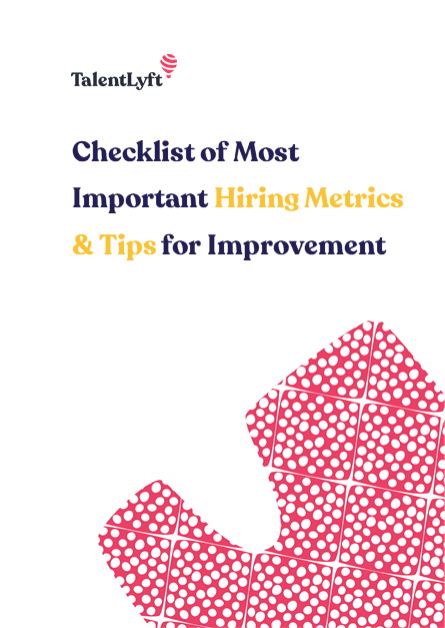![https://adoptoprod.blob.core.windows.net/article/vcURrUsr-E2tEb3TGcsVmQ.png?8393]()
What is time-to-hire?
Time-to-hire is one of the key recruiting and hiring metrics. Time-to-hire shares the pedestal with cost-per-hire and quality-of-hire. These 3 metrics are the most important and most frequently used recruitment metrics.
➡️ Download the Checklist of Most Important Hiring Metrics & Tips for Improvement!
Time-to-hire metric measures how quickly a company can select and hire the best candidate. It will tell you how many days your HR team needs to fill your open job position.
Time-to-hire vs. time-to-fill
Time-to-hire is often used as a synonym for time-to-fill. This is a mistake! Time-to-hire and time-to-fill are two completely different metrics.
The difference between these two metrics is in the starting point:
- Time-to-fill counts the days from the date when you’ve published your new job opening.
The date when a job requisition is submitted for approval or the date when approval is given to start filling a position may be used instead of the date when the open position is published. - Time-to-hire counts the days from the date when the candidate has entered your pipeline.
In other words, a starting point for measuring time-to-hire is when you have your candidate (applied or sourced).
In short:
- Time-to-fill answers the question: How long is your whole recruitment process, from creating a new job opening to hiring someone?
- Time-to-hire answers the question: After you have candidates (sourced or applied) for a job opening, how many days does it take to hire someone?
Conclusion:
- Time-to-fill will tell you how many days you need to fill a position once you’ve defined the need for hiring a new employee.
Thus, this metric is very useful for planning your hiring needs. - Time-to-hire will tell you how quickly you can select the best candidate once you have a pipeline of suitable candidates.
Thus, this metric is very useful for validating the efficiency of your selection process.
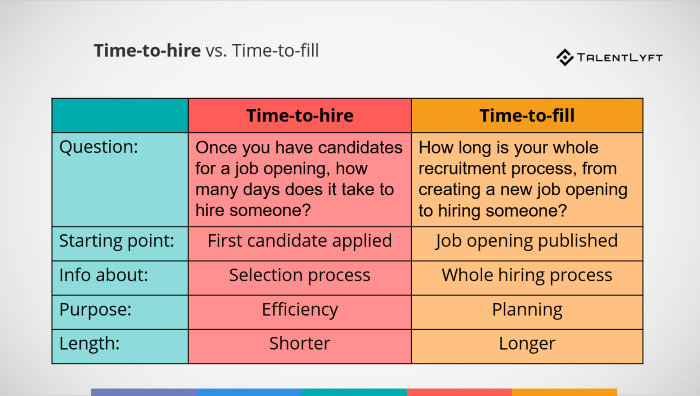
Although these two metrics may seem similar at first, you shouldn’t use them interchangeably.
Time-to-fill is always longer than time-to-hire because it measures the time needed to get approval for hiring a new employee, publishing and advertising your new open job position and the time needed for the first candidate to apply.
How to calculate time-to-hire?
Time-to-hire is the number of days passed since a candidate entered your pipeline until the day you hire a new employee.
Here is the formula to calculate your time-to-hire:
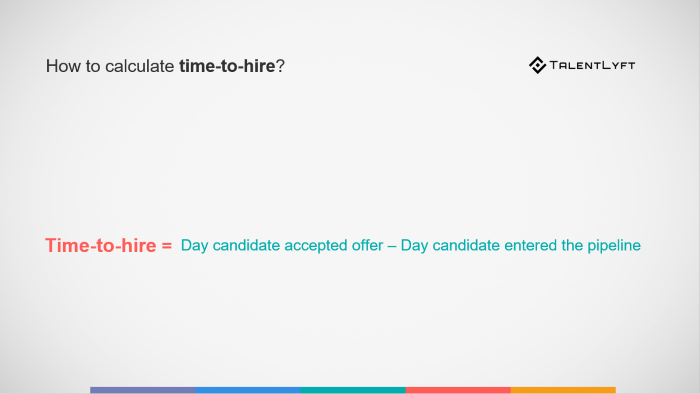
You can also calculate your average time-to-hire.
For example, let’s say you had 3 job openings in the last month. How to calculate your average time-to-hire?
Simply add time-to-hire for your first, second and third open job position and divide the sum by the total number of job openings (in this case, 3).
Here is the formula for calculating the average time-to-hire:
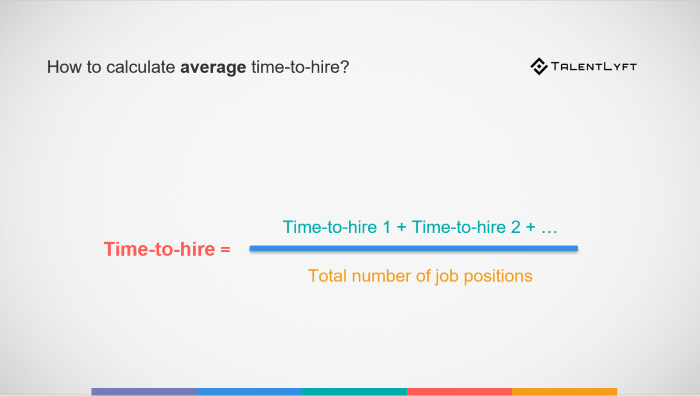
You can calculate an average time-to-hire for a certain department, location, etc. during different time periods, such as a month, quarter. year, etc.
What is the average time-to-hire?
Here is some useful information you can use to benchmark your time-to-hire:
A recent survey conducted by Spark Hire for their 2018 Growth Hiring Trends Report surveyed 500 talent acquisition professionals in the United States. They found that for 49% of the survey respondents, 7 to 14 days from receipt of an application to offer letter was the norm; 24% of companies reported that it takes them 15 to 30 days to make a hire.
According to LinkedIn, only 30% of companies are able to fill a vacant role within 30 days. The other 70% of companies take anywhere between 1 - 4 months to process a new hire.
The Society of Human Resource Management (SHRM) 2017 Talent Acquisition Benchmarking Report has found that the average time-to-fill a position is 36 days.
Note that some of these reports use time-to-hire as a metric and other time-to-fill.
It is also important to highlight that an average time to hire can differ regarding different industries and specific roles, departments, cities, countries, cities etc.
Why is it important to measure time-to-hire?
Time-to-hire is one of the top 3 most important hiring and recruitment metrics.
According to LinkedIn’s research, time-to-hire is a so-called “north star” metric, the second metric they use to measure their hiring success.
Why is time-to-hire so important?
Time-to-hire is an excellent metric to evaluate the efficiency of your selection process. A long time-to-hire raises the cost of your hiring, but it can also cause you to lose top candidates.
Robert Half's research has found that a whopping 57% of job seekers lose interest in a job if the hiring process is lengthy.
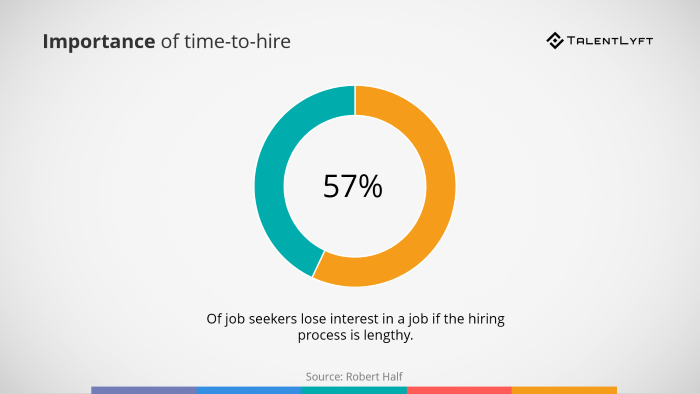
Thus, reducing the time to hire is a great way to reduce your cost-per-hire and improve your candidate experience.
How to improve time-to-hire?
One of the best ways to reduce your time-to-hire is to use modern recruitment software.
According to research, 86% of recruiting professionals say that using an ATS has helped them hire faster.

Modern recruitment software has many benefits and different features that enable companies to significantly reduce their time-to-hire.
Here are the top 5 ways in which recruitment software reduces time to hire:
Data Analytics
Modern recruitment software will automatically track and measure your time-to-hire. That way you can get an insight into how long it takes to hire for a particular job opening and make changes accordingly. For example, you can notice that a certain stage of your selection process takes too long and find solutions to resolve such bottlenecks.
Email automation
Modern recruitment software has ready-to-use recruiting email templates you can personalize and send in bulk. That way, you can save a lot of time and ensure that you communicate with every candidate on time with a personalized message.
Automated interview scheduling
With modern recruitment software, you can send automated emails with an interview appointment that automatically sinks into your work calendar. That way you’ll save valuable time going back and forth to arrange a suitable time slot for all your candidates.
Automated resume parsing and screening
Once candidates apply, modern recruitment software will parse and screen their resumes and create their rich profiles in the system automatically. That way you’ll save the time needed to go through all received applications and organize them in order to find the best candidates.
Automated disqualification of unqualified candidates
With a modern recruitment tool, you can automatically screen application forms and eliminate candidates who are not qualified. That way, you’ll be able to quickly and efficiently eliminate unsuitable candidates at the start of your selection process and save time you would otherwise waste on them.
Can TalentLyft help you improve time-to-hire?
With TalentLyft, you can leverage actionable data to improve your hiring decisions and automate workflows for a faster and smoother hiring process.
Request a demo! Bonus idea for reducing your time-to-hire: Conduct group interviews!
If you want to reduce your time-to-fill by finding candidates faster, try these tactics:
Frequently asked questions
What is the Difference Between Time-to-Hire and Time-to-Fill in Recruitment?
Time-to-hire and time-to-fill are different recruitment metrics. Time-to-hire measures the days from when a candidate enters the recruitment pipeline to when they are hired. Time-to-fill counts the days from the job requisition or publication to when a candidate is hired. Time-to-fill is generally longer as it includes the entire recruitment process.
How Do You Calculate Time-to-Hire?
To calculate time-to-hire, count the number of days passed since a candidate entered your pipeline until the day you hire a new employee. For an average time-to-hire, add the time-to-hire for each open position and divide by the number of positions. This metric helps in assessing the efficiency of the recruitment process.
What is the Average Time-to-Hire?
The average time-to-hire can vary based on industry, location, and job role. Research by Spark Hire found that for 49% of their respondents, the norm was 7 to 14 days from application to offer. LinkedIn reports that only 30% of companies fill a role within 30 days, with others taking 1-4 months. SHRM found an average time-to-fill of 36 days.
Why is Measuring Time-to-Hire Important?
Measuring time-to-hire is important because it evaluates the efficiency of the selection process. A lengthy time-to-hire can increase hiring costs and result in losing top candidates. Understanding this metric helps in optimizing recruitment strategies for quicker and more effective hiring.
How Can Companies Improve Their Time-to-Hire?
Companies can improve time-to-hire by using modern recruitment software which includes features like data analytics, email automation, automated interview scheduling, and resume parsing. These tools streamline the recruitment process, reduce manual tasks, and enable quicker decision-making, thereby reducing the overall time-to-hire.
![Boolean Search for Recruiters [Actionable Guide]](https://adoptoprod.blob.core.windows.net/article/7wyu_xAg806Tm_lmFg71Rw.png)










